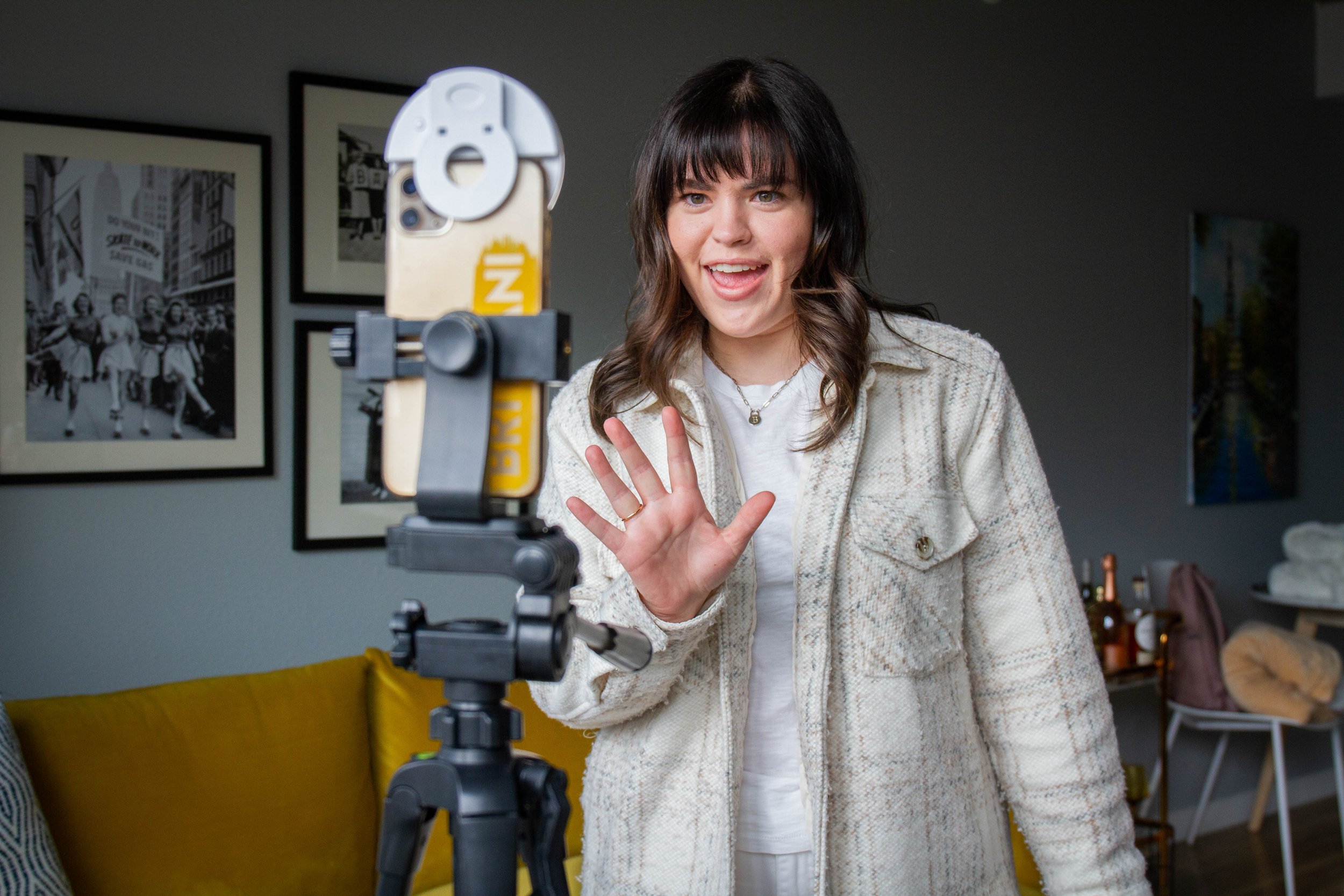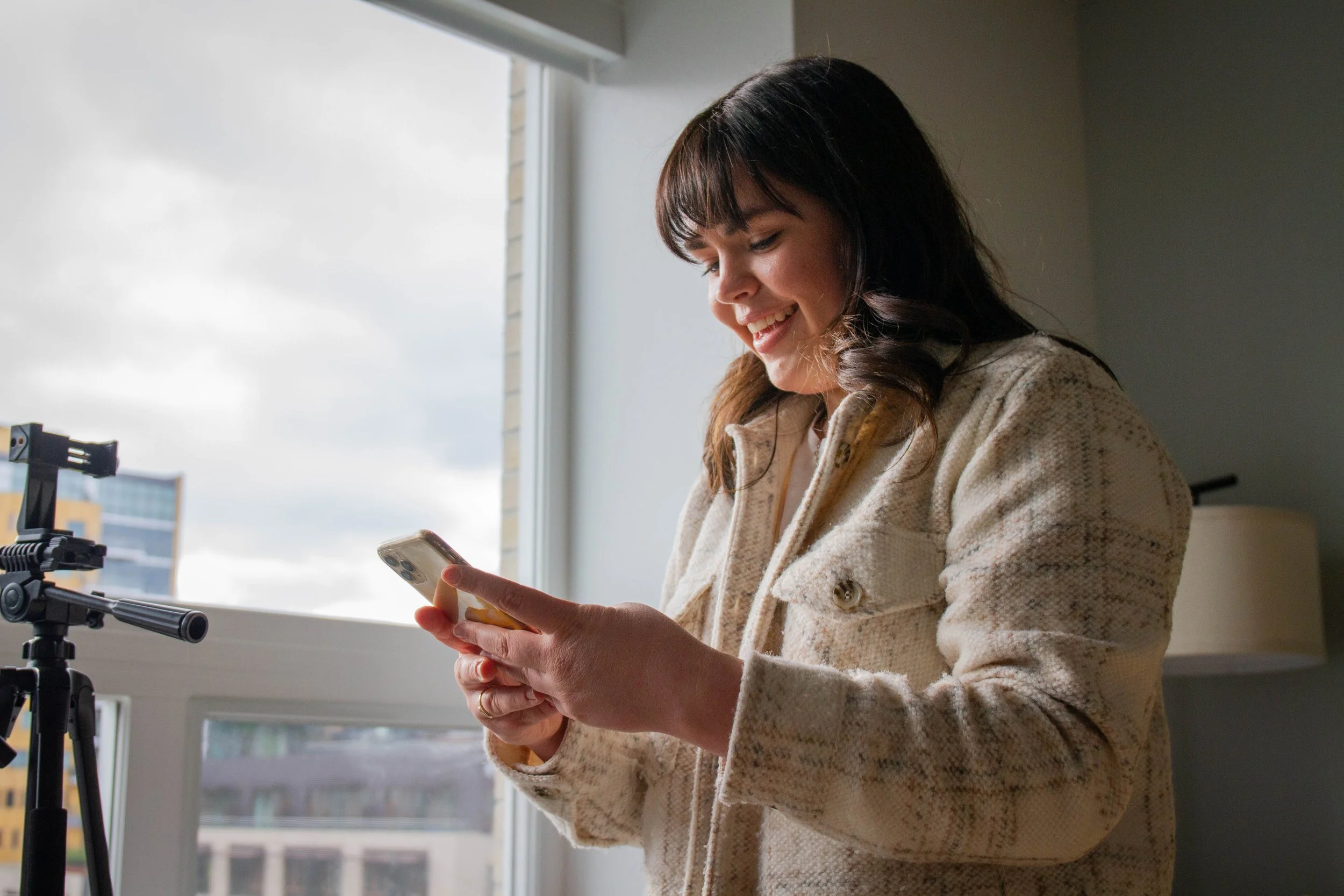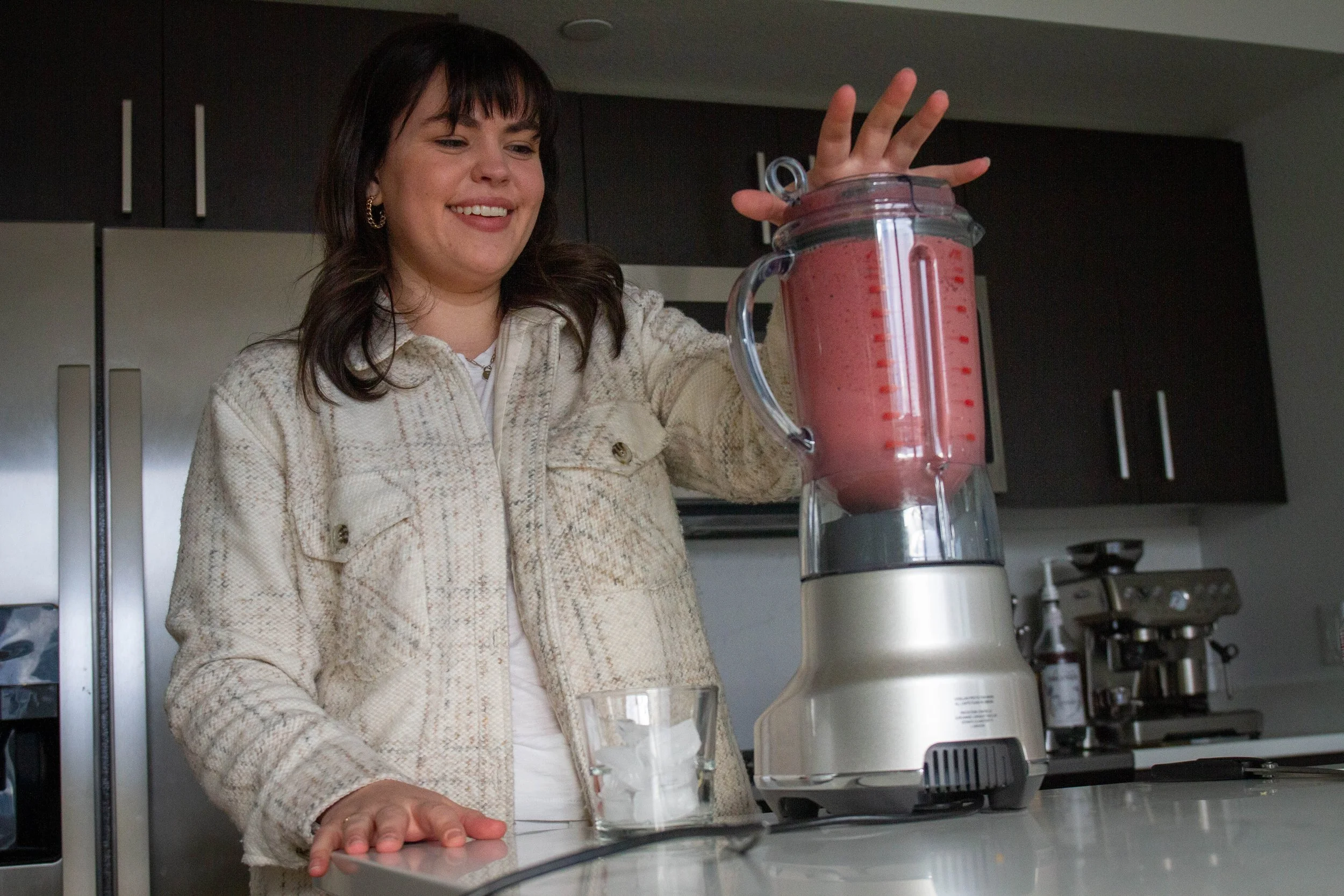
Any(Body) Can Go Viral
As featured in the 2022 issue of FLUX Magazine.
How one woman learned to love herself and help others do the same.
When Brittani Lancaster arrives back at her Portland apartment after work at 4 p.m. on a recent Friday, she sets her things down, greets her 10-week-old puppy and clocks into her part-time passion.
She opens up her notebook, scrolls through TikTok and starts brainstorming ideas for videos to upload to her profile that night.
A handful of songs are trending on the video-sharing platform currently; Lancaster is drawn to a 20-second, upbeat song that users have been recording themselves dancing to, often in sports bras or swimsuits.
Lancaster loves the dance but hesitates to record her own version of it. Her body doesn’t look like the other girls dancing to the song. She can’t help but compare her stretch marks and hip dips to their thin figures and clear skin. Then she realizes: That’s why she does what she does.
She rummages through her closet, pulling out a pair of salmon-colored spandex and her favorite blue sports bra. She positions her phone on a tripod so that her whole body, stretch marks and all, are visible on the screen.
When Lancaster starts to dance, her face lights up — even in the second, third and fourth take. Her smile is radiant, and her energy is contagious.
As her video uploads, Lancaster says, “I feel like that one was good!”
She excitedly rewatches the video and starts rattling off things she could caption it with. She lands on “Hip dips, cellulite, stretch marks, bacne, & jiggly skin can’t stop me from KILLING this dance!!”
“I just want to show a more realistic view of this trend,” Lancaster says as her video uploads. After all, that’s what her platform is all about: helping others feel confident in their own imperfect skin.
Lancaster, 24, is a body-positivity activist who encourages the acceptance of every body type, shape and size. She has amassed one million followers on the video-sharing platforms Tik Tok and Instagram since graduating from the University of Oregon in 2020. Her videos promote self-love and positivity infused with her colorful creativity.
Her profile is filled with all kinds of videos. Some consist of her dancing, some feature trending sounds with a body-positive spin, and others just show Lancaster speaking directly to her followers about her, or their, experiences. Some of her most popular, however, are her signature “What I Eat in a Day” videos where she brings her followers with her throughout the day, showing them, well, what she eats.
No matter the style, Lancaster strives to ensure that every video will achieve the same goal: making at least one person struggling with eating disorders and/or body image feel less alone. Why? Because she knows how it feels.
Lancaster typing up a caption for a TikTok video before posting it to her page; Photo by William Takahashi
As a young girl growing up in Florida, Lancaster was always the bigger girl in her class. She spent most of her childhood unaware that she was larger than most of her peers who were the same age, but external messages from people and society eventually started chipping away at her youthful innocence.
The first time she realized that her body was different than her peers’ was when her friend’s grandfather warned her not to go on a swing because he didn't think the swing could “hold that much weight.” Lancaster was 12.
Moments like this followed Lancaster after her move from Florida to Portland during her early adolescent years, from around age 14 to 16. She began to convince herself that she needed to be in a smaller body. “I thought, ‘I’ll like myself more, I’ll be prettier, guys will like me more if I’m smaller,” Lancaster says. “You know, high school thoughts that a lot of girls have whether they’re willing to admit it or not.”
After a discouraging water polo match her sophomore year of high school, Lancaster went out to eat with her family. She had been limiting the amount of food she was eating for a couple of days prior to that night because she thought eating less would make her thinner. But when she got to dinner, the sadness she felt due to the match and the starvation she felt from not eating caused her to splurge. On her way back home, she broke down crying because “athletes are supposed to be thin,” which is what she told her mom.
When she got home that night, she made a pact with herself to “do whatever I have to do to be smaller.” That was when Lancaster became fixated on losing weight. She avoided eating in order to achieve that new goal. Pieces of her hair quickly started falling out, she lost her period for almost a year and she frequented the emergency room on multiple occasions. At 16, she was diagnosed with her first eating disorder: anorexia.
“She would miss out on so much family time,” says her stepmother, Deb. “We would go to dinner and she would stay home because she wouldn’t order anything and she didn’t want us to see that.”
When doctors told Lancaster two years later that the state of her health put her at risk of becoming infertile later in life, she did a complete 180. She began eating again, but her already unstable relationship with food and her body led to her quickly developing a new eating disorder: binge eating.
She gained weight at an unhealthy rate, leaving her frustrated, confused and angry with herself for losing control. “I was feeling really down about myself,” Lancaster says. “I didn’t have a healthy relationship with my body or with food and I felt really hopeless. I would think, ‘Is it ever going to get better? Am I ever going to like what I see in the mirror?”
When her family took a trip to Europe in 2016, Lancaster’s mind was completely occupied with negative thoughts about herself and food. She spent the trip covering up at the beach, avoiding mirrors and saying “I’m just not hungry” at mealtime.
On the last day, her family visited a beach town in Croatia.
With her brother swimming in the Adriatic sea and her parents making dinner reservations, Lancaster found herself sitting alone on a smooth, slanted rock. Though her mind had been occupied by anxiety and fear all week, now her thoughts were still. The moment was serene, which was an unfamiliar feeling for her. As her eyes searched for the end of the water, not a speck of land or even a building in sight to stop it, the realization hit.
“My life is just a blip in this universe,” she recalls thinking, letting the beauty of the moment finally sink in. “I don’t want to spend it hating myself, hating my body and never feeling comfortable with food.”
That night, Lancaster told her parents that she wanted to commit to getting help for her eating disorders. After she got off the plane in Portland the next day, she sought out eating disorder therapists for the first time. She began recovery with professional guidance and a fresh new mindset, “Life is so short and tomorrow is never promised. Even though that sounds cheesy it’s true,” she says. “I don’t know if I would have started recovery if I hadn’t had that big ‘aha’ realization.”
Lancaster in her Portland apartment blending her favorite smoothie; Photo by William Takahashi
She entered the University of Oregon two weeks later, still in the very early stages of her recovery journey. While starting her freshman year was scary, she found comfort in opening up to new friends she met at school. Her best friend, Ally Rooney, whom she met when pledging a sorority, says Lancaster always found joy in making connections. “She’s an introvert,” says Rooney, who graduated from the UO with Lancaster in 2020, “but she gets a kind of high when she meets someone and has that connection and can make an impact.”
Rooney remembers watching Lancaster realize that she could help more than just her close circle of friends. Their senior year, Lancaster opened up to her entire sorority on the last night of recruitment, during what is called “pref night.” She read a personal story about her experiences to a room lit up with twinkly lights and full of young girls wearing gorgeous dresses.
When she finished speaking, tears rolled down the faces of the women in the room.
“I think she realized, ‘If I vocalize this and really got it out there, I could help more than just my friends,” Rooney says. “She had this perspective change that she could make a difference by becoming vulnerable to not just the people around her, but everyone.”
When TikTok came onto the social media scene in late 2019, Lancaster didn’t consider that it would eventually become a tool she would use to help thousands. In fact, she didn’t post a body-positivity-related video until months after she downloaded the app. But on February 9, 2020, Lancaster took a 15-second video of herself before her sorority formal dancing in a pink, tight, satin dress, with the caption, “Today marks 3.5 years of recovery from my eating disorder! You are beautiful.”
That was her first video to go viral, garnishing 107.2 thousand likes and over 300 comments. Lancaster quickly realized that she could reach young girls around the world, not just in her home state, and began posting more and more eating disorder and body positivity-related videos. Since then, Lancaster has become one of the most popular body-positivity influencers on TikTok, with almost 1 million followers and over 75 million likes.
“It’s the most beautiful feeling,” Lancaster says. “Getting to meet people who tell me ‘you helped me get help for my eating disorder, I finally told my parents that I was struggling because of your videos, your videos helped me eat.” Lancaster knows how hard it can be for someone with an eating disorder to do something as seemingly simple as eating. That’s why she says these messages are so meaningful: because she’s been in their shoes.
“I had such negative confidence and always felt like I had to change myself when I had my eating disorder,” Lancaster says, “So to be able to help somebody not have those feelings is really beautiful.”
One of those people is Julia Mastanduno, who knows how impactful Lancaster can be. In November, Mastanduno returned to her New Jersey home from an eating disorder treatment center. As she sat in bed, scrolling through TikTok, she saw Lancaster’s video pop up on her screen.
She watched Lancaster dance in salmon-colored spandex and a blue sports bra and she read the caption “Hip dips, cellulite, stretch marks, bacne, & jiggly skin can’t stop me from KILLING this dance!!”
“She brought me out of a dark place,” Mastanduno, 21, says. “She wasn’t letting things like cellulite and stretch marks hold her back from dancing and having fun. I really strive to be like that, to acknowledge that those things are there but not let them prevent me from doing anything I want to do.”
As the video ended, Mastanduno opened up the comment section and typed, “Hi Brit! I love you! I hope you’re having a great night. Thank you for making me feel less insecure.”
On the other side of the country, Lancaster saw Mastanduno’s message. She doesn’t always have time to reply to everyone who comments on her posts. Her TikToks often generate hundreds of comments, but this time she did: “I love you too!” Lancaster typed. “You are wonderfully made!”
// Follow Brittani on Tik Tok @brittanilancaster and Instagram @brittanilancaster

